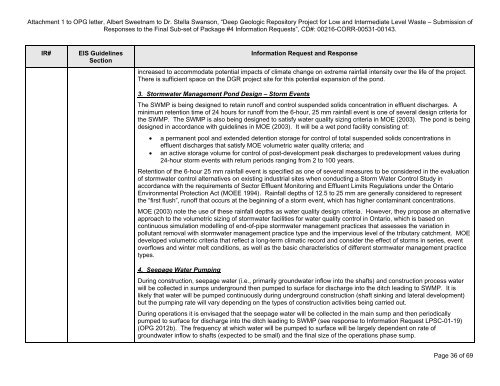Ontario Power Generation's Response to the Joint Review
Ontario Power Generation's Response to the Joint Review
Ontario Power Generation's Response to the Joint Review
You also want an ePaper? Increase the reach of your titles
YUMPU automatically turns print PDFs into web optimized ePapers that Google loves.
Attachment 1 <strong>to</strong> OPG letter, Albert Sweetnam <strong>to</strong> Dr. Stella Swanson, “Deep Geologic Reposi<strong>to</strong>ry Project for Low and Intermediate Level Waste – Submission of<br />
<strong>Response</strong>s <strong>to</strong> <strong>the</strong> Final Sub-set of Package #4 Information Requests”, CD#: 00216-CORR-00531-00143.<br />
IR# EIS Guidelines<br />
Section<br />
Information Request and <strong>Response</strong><br />
increased <strong>to</strong> accommodate potential impacts of climate change on extreme rainfall intensity over <strong>the</strong> life of <strong>the</strong> project.<br />
There is sufficient space on <strong>the</strong> DGR project site for this potential expansion of <strong>the</strong> pond.<br />
3. S<strong>to</strong>rmwater Management Pond Design – S<strong>to</strong>rm Events<br />
The SWMP is being designed <strong>to</strong> retain runoff and control suspended solids concentration in effluent discharges. A<br />
minimum retention time of 24 hours for runoff from <strong>the</strong> 6-hour, 25 mm rainfall event is one of several design criteria for<br />
<strong>the</strong> SWMP. The SWMP is also being designed <strong>to</strong> satisfy water quality sizing criteria in MOE (2003). The pond is being<br />
designed in accordance with guidelines in MOE (2003). It will be a wet pond facility consisting of:<br />
� a permanent pool and extended detention s<strong>to</strong>rage for control of <strong>to</strong>tal suspended solids concentrations in<br />
effluent discharges that satisfy MOE volumetric water quality criteria; and<br />
� an active s<strong>to</strong>rage volume for control of post-development peak discharges <strong>to</strong> predevelopment values during<br />
24-hour s<strong>to</strong>rm events with return periods ranging from 2 <strong>to</strong> 100 years.<br />
Retention of <strong>the</strong> 6-hour 25 mm rainfall event is specified as one of several measures <strong>to</strong> be considered in <strong>the</strong> evaluation<br />
of s<strong>to</strong>rmwater control alternatives on existing industrial sites when conducting a S<strong>to</strong>rm Water Control Study in<br />
accordance with <strong>the</strong> requirements of Sec<strong>to</strong>r Effluent Moni<strong>to</strong>ring and Effluent Limits Regulations under <strong>the</strong> <strong>Ontario</strong><br />
Environmental Protection Act (MOEE 1994). Rainfall depths of 12.5 <strong>to</strong> 25 mm are generally considered <strong>to</strong> represent<br />
<strong>the</strong> “first flush”, runoff that occurs at <strong>the</strong> beginning of a s<strong>to</strong>rm event, which has higher contaminant concentrations.<br />
MOE (2003) note <strong>the</strong> use of <strong>the</strong>se rainfall depths as water quality design criteria. However, <strong>the</strong>y propose an alternative<br />
approach <strong>to</strong> <strong>the</strong> volumetric sizing of s<strong>to</strong>rmwater facilities for water quality control in <strong>Ontario</strong>, which is based on<br />
continuous simulation modelling of end-of-pipe s<strong>to</strong>rmwater management practices that assesses <strong>the</strong> variation in<br />
pollutant removal with s<strong>to</strong>rmwater management practice type and <strong>the</strong> impervious level of <strong>the</strong> tributary catchment. MOE<br />
developed volumetric criteria that reflect a long-term climatic record and consider <strong>the</strong> effect of s<strong>to</strong>rms in series, event<br />
overflows and winter melt conditions, as well as <strong>the</strong> basic characteristics of different s<strong>to</strong>rmwater management practice<br />
types.<br />
4. Seepage Water Pumping<br />
During construction, seepage water (i.e., primarily groundwater inflow in<strong>to</strong> <strong>the</strong> shafts) and construction process water<br />
will be collected in sumps underground <strong>the</strong>n pumped <strong>to</strong> surface for discharge in<strong>to</strong> <strong>the</strong> ditch leading <strong>to</strong> SWMP. It is<br />
likely that water will be pumped continuously during underground construction (shaft sinking and lateral development)<br />
but <strong>the</strong> pumping rate will vary depending on <strong>the</strong> types of construction activities being carried out.<br />
During operations it is envisaged that <strong>the</strong> seepage water will be collected in <strong>the</strong> main sump and <strong>the</strong>n periodically<br />
pumped <strong>to</strong> surface for discharge in<strong>to</strong> <strong>the</strong> ditch leading <strong>to</strong> SWMP (see response <strong>to</strong> Information Request LPSC-01-19)<br />
(OPG 2012b). The frequency at which water will be pumped <strong>to</strong> surface will be largely dependent on rate of<br />
groundwater inflow <strong>to</strong> shafts (expected <strong>to</strong> be small) and <strong>the</strong> final size of <strong>the</strong> operations phase sump.<br />
Page 36 of 69
















